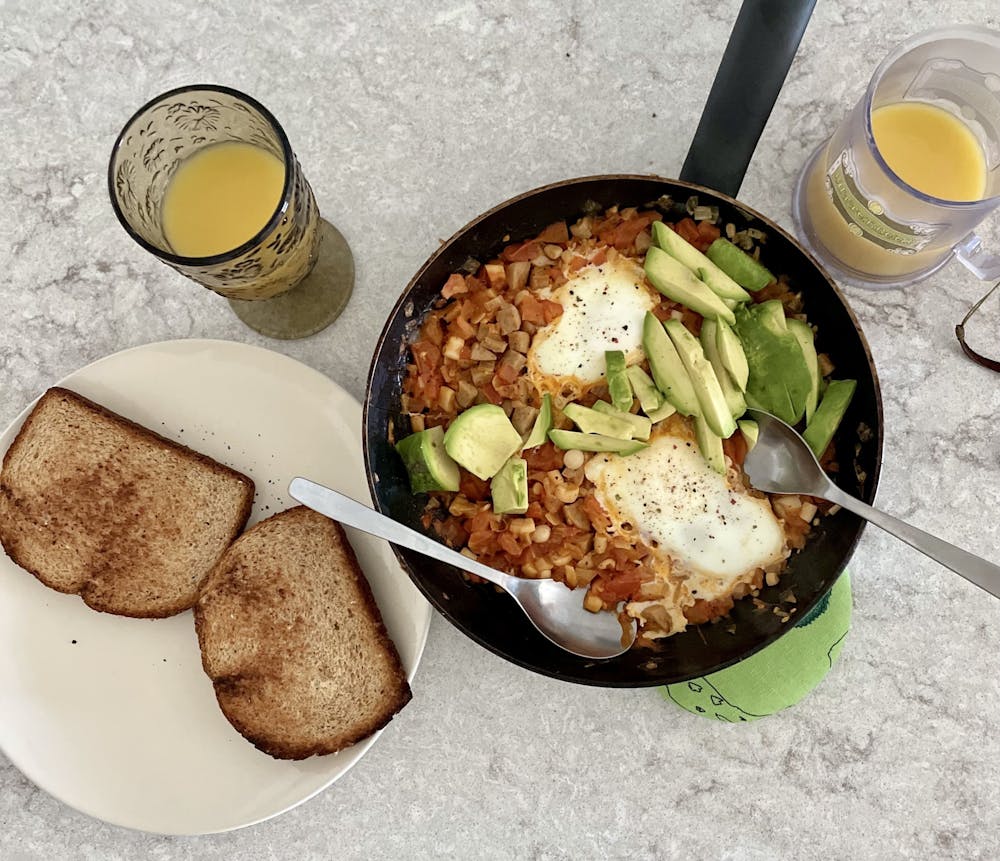Truth be told, I did not cook once throughout my freshman year. Committed to using up my meal swipes every week, I often chose to traverse across campus to Nolan’s for a piece of burned (or raw) chicken, when I could have cooked up something nice and normal for myself. To help you avoid making the same mistakes I did, here are four of my favorite recipes for dorm room cooking!
Before that, buy kitchenware!
Buying kitchenware is the first and most important step to freeing yourself from the meal plan mindset. Once you’ve invested in pots and pans and are surrounded by their constant presence, you will feel the urge to start cooking! As for groceries, without a car, the best options are to take either the Hopkins shuttle to Giant or the bus to Safeway (or shop online on Instacart).
Recipes
Note for beginners: The cooking time is only for reference. Given that Hopkins dorm stoves tend to be... finicky, it is best to cook for longer and rely on your inner masterchef instinct. I personally hate using tablespoons or cups or whatever precise measurements when cooking. Beyond trusting your instincts, taste testing and adjusting is the best approach — if dry or salty, add water; if raw or damp, cook for longer; if bland, add sauce.
Shakshuka — great for brunch
Ingredients
- Olive oil
- 2 ripe tomatoes and tomato sauce (or 1 canned diced tomato)
- 1/2 of an onion
- Some mushrooms
- 1 red pepper
- 2 eggs
- Black pepper
- Paprika
- Chili powder
Steps:
- Start by dicing the onions, tomatoes, mushrooms and red pepper.
- Sauté the onions and red pepper in olive oil.
- Stir and cook for three to five minutes. Once they are tender, add in the mushrooms and tomatoes. Use your spatula to press against the tomatoes so that the flavor and juice come out. If you are using fresh tomatoes that are not as juicy, add some tomato sauce and water. The texture should be mushy and watery.
- Add in the spices.
- Cover and let simmer for about five minutes.
- Make two holes in the sauce and crack the eggs into them. Cover the pan again and let them cook over low heat for three to five minutes, depending on how you like your eggs.
- Enjoy with some bread!
Kimchi fried rice — great for late-night Netflix binging
Ingredients
- Olive oil
- Cooked rice
- Kimchi with juice (I usually get the Chongga Mat Kimchi, but CharMar also has some if you want to use up your dining dollars)
- Soy sauce
- Gochujang (Korean chili paste)
- SPAM (pork belly is best, but SPAM is easiest)
- Optional: 1 egg and seaweed
Steps:
- Dice the SPAM and cut up the kimchi into smaller pieces.
- Stir fry the SPAM in a pan with olive oil until browned, then add in the kimchi. Make sure to pour in some kimchi juice, otherwise the dish will be very dry.
- Add in the soy sauce and gochujang. Cook for three to five minutes until the kimchi begins to caramelize, then add in cooked rice and stir.
- Continue to cook and stir for about five minutes until the rice begins to char. If you like it crispy like me, put the stove on the highest heat and cook for a bit longer.
- Optional: Serve the fried rice with a sunny-side-up egg (chef’s kiss) and some seaweed!
Korean cold noodles — great for hot summer days
Ingredients
- Store-bought Korean cold noodles with broth
- 1 cucumber
- 1 apple or pear
- Kimchi
- 1 egg
- Optional: Beef brisket
Steps:
- This doesn’t require much cooking, as I usually cheat and buy pre-made Korean cold noodles with broth packs. They are absolutely amazing! So buy those, and prepare them as per the instructions.
- Slice the cucumber and apple or pear into strips.
- Boil the egg for 10 to 12 minutes until hard-boiled, then slice.
- If you have the time and resources, you can cook and slice beef brisket (boil for at least one hour).
- Assemble everything together and enjoy! I sometimes like to add in ice cubes as well when it’s extra hot.
Chinese Steam Egg — great for sick days
Ingredients
- Water
- 3 eggs
- Green onion
- Soy sauce
- Salt
- Optional: Clam or ground pork for a more advanced version
Steps:
- Beat the eggs with a pinch of salt. Scoop out the foams so that the egg liquid is smooth. Don’t throw away the eggshells!
- Pour warm water into the eggs. The egg:water ratio is super important: should be egg:water = 1:1.5. I like to use the eggshell from step one as a measuring tool. So three whole eggs would require nine half-shells of water.
- Cover the bowl with plastic wrap or another plate. Steam for 10 to 15 minutes over low to medium heat. Let sit in the pan for an additional five minutes after you turn the stove off.
- Make a few cuts on the steamed egg (so that the sauce can sink in) and pour some soy sauce into it. Sprinkle some freshly chopped green onion on top, and enjoy!
Cathy Wang is a junior from Shanghai, China majoring in Applied Mathematics and Statistics and International Studies. She is a Managing Editor for The News-Letter.





